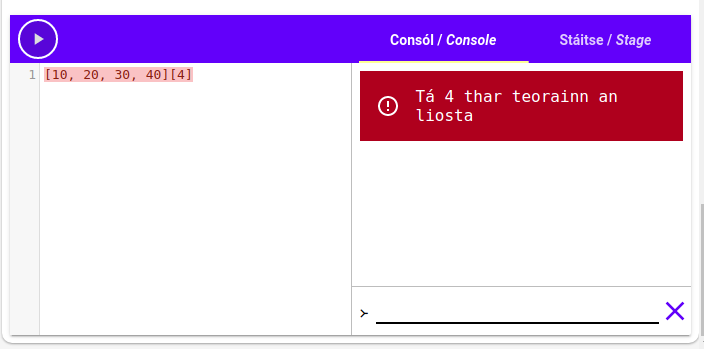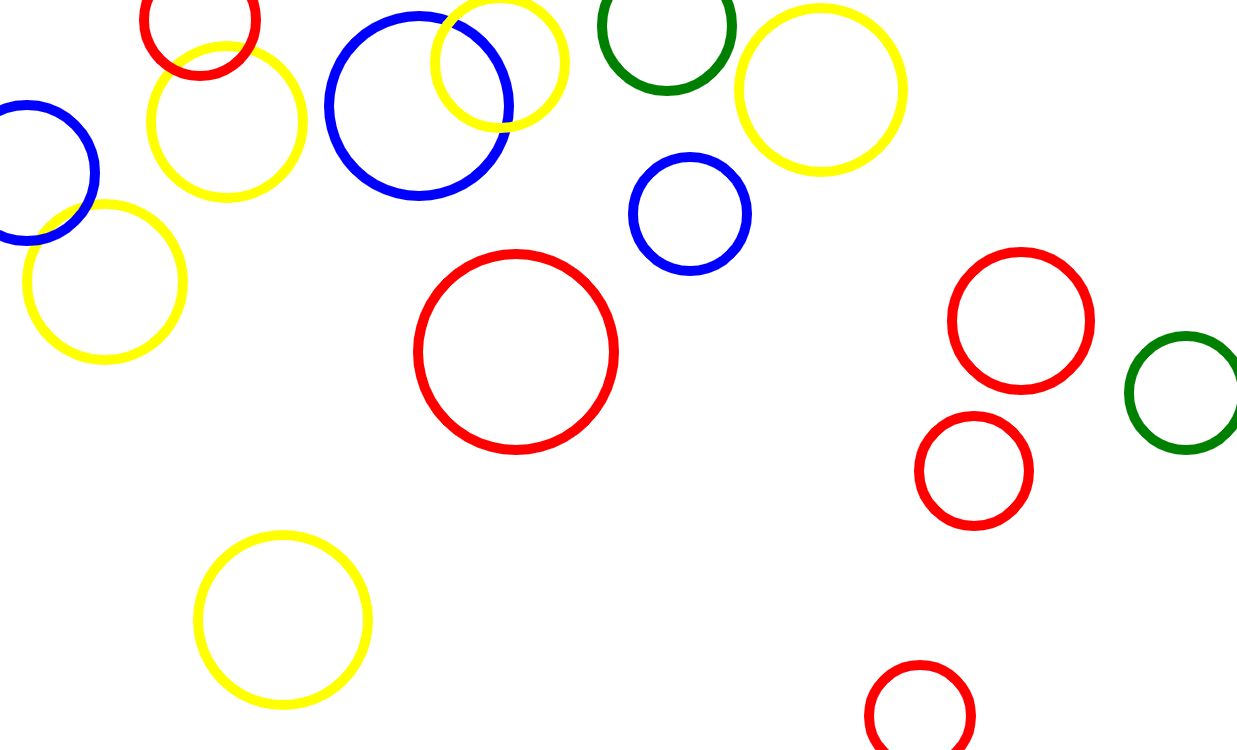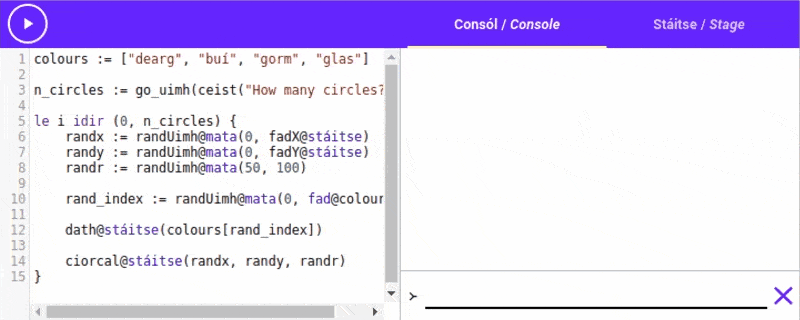- Tutorial Introduction
- What is programming?
- Take the Stage!
- It's decision time
- Lists 'n Loops
- In the Loop
- Time for Action
- Some Useful Actions
- Game Time!
- Let's Paint
- Outlines
- Scope
Lists ’n Loops
Lists
So far in Setanta we’ve only been using text and numbers in our programs. These have allowed us to do some powerful stuff, but they are also very limiting.
What if we want to deal with more than one piece of text, or more than one number. That’s where
Making lists
Lists are created with [, ]) around the outside and commas (,) to [100, 200, 300] is a list with 3 elements. 100 is the first element, 200 is the second, and 300 is the last element. [] is an empty list.
Try adding 4 as a fourth element to the list [1, 2, 3] here:
In that example
Joining lists
Lists can be +” operator, just like text and numbers.
Using + with two lists creates a
We can use this to add elements to the
Explanation:
- On the first line,
we create a new list[1, 2, 3], and put it in the new variable “x”. - On the second line we
update the variablexwith the valuex + [4]. The value stored inxis[1, 2, 3], so this evaluates to[1, 2, 3] + [4]which equals[1, 2, 3, 4]. We then update the variablexto this value. - On the third line we print
x, which is now[1, 2, 3, 4].
Access
Now that we know how to make lists, and how to put values into the lists, how do we get values back out?
The

We use square brackets ([]) again to access an element at a specific index. We wrap the index in square brackets and place it our_list, we can access the first element by writing our_list[0], the second element by writing our_list[1], and so on. Here’s an example you can play with:
Try changing the 0 on line 5 to a different number and see what happens.
Out of bounds
Our list [10, 20, 30, 40] in the last example is only 4 elements
You should get an

If a list has some
Length
We often want to know our_list, we write fad@our_list to get the length. Try it out!:
(
This can be very useful if we want to get the fad@our_list - 1. Try it out here:
Text vs lists
Text can be thought of as a list of
E.g.
Loop-de-loop
Now that we have our lists, what can we do with them. The main tool that we will use with lists are called “
Loops give us a way of taking some piece of code and repeating it over and over. We’ll take a look at
Le idir
Our first type of loop we’re going to look at is called the “
The syntax for a “le idir” loop is:
How a “le idir” loop works is:
- The Setanta interpreter creates a new variable, with the name we gave (“<variable>”). This is called the loop variable.
- Then it assigns this variable the “<start>” value.
- It runs the code between the curly braces (
{ }). - It then
increases the value in the loop variable. - It checks if the loop variable is equal to the “<finish>” value. If it is,
it exits the “le idir” loop andcontinues on after. - If the loop variable wasn’t equal to the finish value, then it
returns to step 3.
This might be a little confusing to read, but it’s easy to see with an example. Let’s run the following code:
Example
Running this code you should see that it writes “0”, then “1”, then “2”, “3”, and “4”. It then writes “
Explanation
To execute the “le idir” loop, Setanta creates a new variable called “i”. We could choose any name for this variable, but in our example we chose “i”.
Setanta first assigns the start value (in our case 0) to i, and then runs the code in the curly braces. This code is scríobh(i). So the first thing that gets written is “0”.
Next Setanta increases the value of i, so now i contains the value 1. It then checks, is i equal to the finish value (in our case 5)? It isn’t, so it returns to step 3 and runs the code scríobh(i). Now however i is 1, so “1” is written on the console.
This continues for 2, 3 and 4.
Finally after Setanta runs the code for 4 it increases the value of i to 5. Now however it checks if i is equal to the finish value, and this time it is. This tells Setanta that we are finished, so it exits the loop and continues on to the next statement.
The next statement is scríobh("Finished"), so it writes “Finished” on the console. This is the last statement so the program finishes.
Printing out a list
Now we will see how to use “le-idir” loops with lists. We will use a loop to print out every element of a list.
Let’s start with a short list:
There are five elements in that list, we want to use each one, because of that we need to use every index. We should write my_list[0], my_list[1], my_list[2], my_list[3] and my_list[4]. To do that, we should use a loop to go from 0 to 4. We saw in the previous example that we can use this list to go from 0 to 4:
Let’s use that again to write every element of the list, try it out:
But now, what happens when we add a new number to the list? There is now a new number 6 in the list, try the code again:
It doesn’t write out “6” on the console! Why? It doesn’t write it because the loop stops when it gets to index 4, and 6 is at index 5. If we want to we can change the finish value from 5 to 6, but is there a smarter way?
Notice that in the first example that 5 is equal to the length of the list, this is not a coincidence! We want the loop to go from 0 to the last index, and we saw before that the last index would be fad@my_list - 1. A “le-idir” loop stops before the finish value", because of that if we use fad@my_list as the finish value, the loop will stop at fad@my_list - 1. This is exactly what we want to do!
Now this is our code:
When you run this now it writes every element of the list! Try out shorter lists and longer lists!
List sum
Let’s explore how we could
>-- Start with some list
my_list := [11, 12, 13, 14, 15]
>-- Use le idir loop to loop over the elements
le i idir (0, fad@my_list) {
}Now we can make a new variable to store the
>-- Start with some list
my_list := [11, 12, 13, 14, 15]
>-- A variable to store the sum of the elements.
sum := 0
>-- Use le idir loop to loop over the elements
le i idir (0, fad@my_list) {
}Then for each element of the list we can add it’s value to the sum with sum = sum + my_list[i]
>-- Start with some list
my_list := [11, 12, 13, 14, 15]
>-- A variable to store the sum of the elements.
sum := 0
>-- Use le idir loop to loop over the elements
le i idir (0, fad@my_list) {
sum = sum + my_list[i]
}Now we just add our final line scríobh(sum) to write the sum of the list on the console. Try out the final code!
Bonus shorthand
We used sum = sum + my_list[i] to add my_list[i] to the sum variable. Setanta has a shorthand for this common problem, the += operator. We can just write sum += my_list[i] to add my_list[i] to the sum.
There is also *=, -= and /= for
Step Up
A le idir loop can also accept a third number, positioned after the start and finish values. This value
For example:
This loop starts at 0 and increases by 2 instead of 1 each time.
Bonus Tip
If the finish value is smaller than the start value, the loop will
Circle Art
Let’s combine what we’ve seen before with our

There are a few new actions and values we’ll have to look at before we start.
Random
First let’s see how do we generate a random number? Lucky for us Setanta has 2 actions that can do that for us, rand and slánuimh_rand. These are maths actions so we access them with rand@mata and slánuimh_rand@mata. (Once again, we’ll see what the @ does in the future).
randreturns a random number between 0 and 1, not necessarily awhole number e.g. 0.5, 0.333 etc.slánuimh_randtakes two arguments and returns a randomwhole number between those 2. e.g.slánuimh_rand(3, 5)will return one of 3, 4 or 5 with equalprobability ..
The names of these actions are rand and slánuimh_rand because “rand” is short for “randamach” meaning “
Try out this code a few times:
You should get different numbers from 0 to 100 each time.
The Stage
If we want to place circles randomly on the stage, we’ll need to know how big it is.
We can access the width and height by accessing the values fad_x@stáitse and fad_y@stáitse.
Try running this code:
If you resize your window you might get different results.
The Art
Ok let’s write our program: First we want to ask the user how many circles they want. ceist to ask for user input, and go_uimh to convert text to numbers.
Now we would like to create that many circles, so we would like to repeat some code n_circles times. We can use a le idir loop for this
n_circles := go_uimh(ceist("How many circles? "))
le i idir (0, n_circles) {
>-- We'll put our circle logic here
}(We’ve named our loop variable i, but we won’t be using it in the loop)
To draw a circle randomly, we want to pick a random X coordinate, a random Y coordinate, and a random radius. We can uses fad_x and fad_y to get the slánuimh_rand to generate a random number in that range by using slánuimh_rand@mata(0, fad_x@stáitse) and slánuimh_rand@mata(0, fad_y@stáitse)
n_circles := go_uimh(ceist("How many circles? "))
le i idir (0, n_circles) {
randx := slánuimh_rand@mata(0, fad_x@stáitse)
randy := slánuimh_rand@mata(0, fad_y@stáitse)
}We’ll just use 50 to 100 as a range for our radius, as we don’t want them
n_circles := go_uimh(ceist("How many circles? "))
le i idir (0, n_circles) {
randx := slánuimh_rand@mata(0, fad_x@stáitse)
randy := slánuimh_rand@mata(0, fad_y@stáitse)
randr := slánuimh_rand@mata(50, 100)
}Now that we’ve picked random coordinates and size, all that’s left is to draw the circles using ciorcal@stáitse.
n_circles := go_uimh(ceist("How many circles? "))
le i idir (0, n_circles) {
randx := slánuimh_rand@mata(0, fad_x@stáitse)
randy := slánuimh_rand@mata(0, fad_y@stáitse)
randr := slánuimh_rand@mata(50, 100)
ciorcal@stáitse(randx, randy, randr)
}Try running the code! You’ll have to type in how many circles you want, then switch tabs to the stage to see the results.
Switch up the colours
It’s a bit boring having all the circles be the same colour. Let’s switch it up using lists!
Let’s make a list of colours we’d like to see and put it at the top of the program.
colours := ["dearg", "buí", "gorm", "glas"]
n_circles := go_uimh(ceist("How many circles? "))
le i idir (0, n_circles) {
randx := slánuimh_rand@mata(0, fad_x@stáitse)
randy := slánuimh_rand@mata(0, fad_y@stáitse)
randr := slánuimh_rand@mata(50, 100)
ciorcal@stáitse(randx, randy, randr)
}I chose “dearg”, “buí”, “gorm” and “glas”. Now when before we draw a circle, we can switch to a random colour from our list.
To pick a random colour we want to pick a random element from the list. We can do this by picking a random index using slánuimh_rand, we want any index between the first (0) and the last (fad@colours - 1). This gives us index := slánuimh_rand@mata(0, fad@colours - 1).
colours := ["dearg", "buí", "gorm", "glas"]
n_circles := go_uimh(ceist("How many circles? "))
le i idir (0, n_circles) {
randx := slánuimh_rand@mata(0, fad_x@stáitse)
randy := slánuimh_rand@mata(0, fad_y@stáitse)
randr := slánuimh_rand@mata(50, 100)
rand_index := slánuimh_rand@mata(0, fad@colours - 1)
ciorcal@stáitse(randx, randy, randr)
}We can use the index now to pick our random colour “colours[rand_index]” and use dath@stáitse to switch to that colour:
colours := ["dearg", "buí", "gorm", "glas"]
n_circles := go_uimh(ceist("How many circles? "))
le i idir (0, n_circles) {
randx := slánuimh_rand@mata(0, fad_x@stáitse)
randy := slánuimh_rand@mata(0, fad_y@stáitse)
randr := slánuimh_rand@mata(50, 100)
rand_index := slánuimh_rand@mata(0, fad@colours - 1)
dath@stáitse(colours[rand_index])
ciorcal@stáitse(randx, randy, randr)
}Now try running the code!
Demo

Challenge
Switch to using ciorcal_lán@stáitse instead of ciorcal, what happens?
(Hint: “